Santa Monica Canyon By The Sea -- Rustic Canyon
Rare promotional brochure and tract map for Santa Monica Canyon, published by L.D. Loomis Company for the Santa Monica Land Company, with design work by Knapp & Woodward.
The map shows the area between Pacific Palisades and Will Rogers State Beach, with the Ocean Avenue extension at the southwest and Terrace Avenue (now Chautauqua Blvd) at the east side and extending north to Mesa Road. Santa Monica Canyon was the area at the intersection of today's Santa Monica and Pacific Palisades, which is now known now as Rustic Canyon.
This would appear to be the first of several tracts developed by the Santa Monica Company. On the verso is a panoramic photo of the mouth of Rustic Canyon and several other early photos, along with a fine promotional tract for Santa Monica Canyon By The Sea.
Drawn by civil engineers Knapp and Woodard, the map was made for Robert Gillis’ Santa Monica Land Company, which bought large amounts of acreage in the canyon and nearby areas during the first years of the 20th century. It takes in a section from the coast up the canyon to where the Santa Monica Forestry Station, established by the state forestry department in 1887 during the Los Angeles boom period of the 1880s to experiment with forest plantings, was located and which is named at the top of the map.
The tract included a total of 533 lots, the first to be created in the canyon. Sales were handled by the L.D. Loomis Company, which promoted the project extensively in areas newspapers in 1912. An article in the Los Angeles Herald in October 1912 discussed Loomis’ meteoric rise to real estate success, including “the phenomenal sale of more than $400,000 worth of property in Santa Monica Canyon in the short period of ten weeks.” The article also notes Lommis's prediction that, in a decade, professionals and businessmen from Los Angeles and the east coast would build “hundreds of substantial homes.”
In the July-August 1913 issue of Out West magazine, the following was written about Santa Monica Canyon by Jay D. Cassatt:
Undoubtedly there is no other place in Southern California appealing more to the nature lover than does beautiful Santa Monica Canyon. Its history dates from the time of the early explorers and Mission Fathers. For many years prior to its subdivision and improvement this famous canyon with its mighty sycamores and cool retreats was the playground for thousands of pleasure seekers . . . there are already examples in the Canyon showing how a cozy home can be built under or around a giant sycamore and thereby produce a pleasing rustic effect. . . Knapp and Woodard, landscape engineers, were given the task of artificially improving the Canyon without interfering with its natural beauty. The result has been one of extreme harmony with preservation of the old trees and shrubbery . . . A visit will convince you that this is the beauty spot in the heart of San Vicente-Santa Monica the Riviera of America.
Rustic Canyon
The first Europeans to visit the area were members of the Portola expedition of 1769. The expedition sought to follow the coastline, but were stopped by the coastal cliffs of the Santa Monica Mountains. The next day they turned around and went inland, finding a way north through Sepulveda Canyon.
Under Mexican rule, the land between Topanga Canyon and present day Santa Monica was in the Rancho Boca de Santa Monica. It was used for grazing and firewood by the prominent Marquez, Reyes, and Sepúlveda families. During the latter 19th-century, the canyon was known as a camping area and rustic retreat near the beach hotels and resorts of nearby Santa Monica. The earliest newspaper advertisements for Santa Monica Canyon as a camping and recreational destination date to 1875.
Abbot Kinney, the developer known for founding the nearby community of Venice Beach to the south, established an experimental forestry station and planted eucalyptus trees in the lower canyon.
Rustic Canyon Recreational Center
During the early 20th century, the Uplifters, an offshoot of the prominent Los Angeles Athletic Club, established a social club and ranch in Rustic Canyon and built many ranch and cabin style houses as second homes for weekend and annual retreats. The Uplifters later developed a relationship with Will Rogers, whose ranch and estate lay on the other side of Sunset, and built a polo field in the canyon. During the Prohibition era, the Uplifters was known as a high-class drinking club, of which many prominent local politicians and wealthy residents of the city were members. The relative isolation of the area provided an ideal retreat for the wealthy and powerful members of the club, who lived primarily in the upscale areas (of the time) near downtown and in Pasadena to indulge their appetites without undue notice.
To the present day, a sign reading "Uplifters Ranch" hangs over Latimer Road near the former Uplifters clubhouse, which was designed by the architect William J. Dodd. Following the Depression the club began to sell off properties in the area, and disbanded in 1947. The clubhouse and adjacent recreational elements, including a swimming pool, baseball diamond, and tennis courts, were donated to the city in the early 1950s. They are now within the Rustic Canyon Recreation Center city park.
Rarity
The map and brochure are very rare. We believe there is another example at the Homestead Museum (Los Angeles) collection.











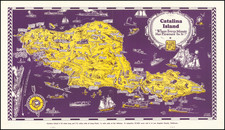
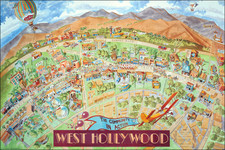
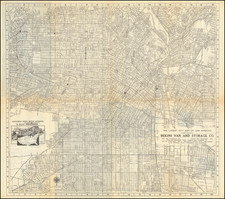
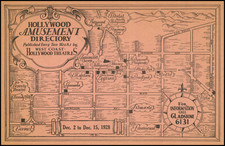
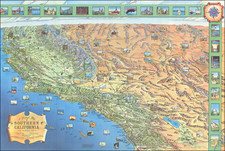
![(Hollywood) [Annotated Real Estate Map of Hollywood]](https://storage.googleapis.com/raremaps/img/small/97362.jpg)